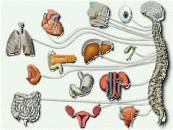Safety of Chiropractic Care
Safety of Chiropractic CareWe are more than the sum of our parts.....
I am often asked about how chiropractic differs in its approach to treating health problems. First, symptoms are only an indication that something is wrong. Second, symptoms are not the primary focus of treatment. Any effective treatment will respect the fact that body systems are fully integrated and interdependent. Click here to view a sample video produced by chiroVmail.com to explain the basis for chiropractic care. (For feedback on this video, please use our email, NOT THE "CONTACT US" BUTTON under the video, as we are only evaluating this system for potential use in patient education.)
To quote Dr. Mercola, "As a result of 'disease mongering,' the more the medical industry influences a nation, the sicker that nation 'considers itself to be.' It eats away at your self-confidence and teaches you that you're weak and incapable of staying well, and that all signs and symptoms are potentially dangerous conditions and diseases. Truly, this sort of marketing has blurred the lines of what drugs and surgery you really need to save your life, and which you don't."
With respect to competency in addressing musculoskeletal problems, the following report is More Bad News For Medical Patients:
A series of articles reporting on the lack of medical training in musculoskeletal disorders was published between 1998 and 2002 by Kevin B. Freedman, MD. It seems that the department chairs of several hospital-based orthopedic residency programs designed a basic examination on musculoskeletal competency and gave it to their residents. 82% of medical school graduates failed the examination. Four years later the test was simplified and, once again, 78% of the examinees failed to demonstrate basic competency in musculoskeletal medicine. When this test was given to final quarter chiropractic students 70% of them passed the same exam!
The differences between these 2 student groups should be noted. The medical students had already graduated from medical school (as MDs) and had currently been deployed in rotation through various hospital departments. They had also been accepted into an orthopedic residency program...as the pinnacle of medical musculoskeletal specialists. The chiropractic examinees, however, were still just students. 80% (graduated) medical failure versus 70% chiropractic (student) success. Quite astonishing!
Here are the references for this report:
The Adequacy of Medical School Education in Musculoskeletal Medicine - Journal of Bone and Joint Surgery 1998 (Oct); 80-A (10): 1421�1427
Educational Deficiencies in Musculoskeletal Medicine - Journal of Bone and Joint Surgery 2002 (Apr); 84�A (4): 604�608
A Comparison of Chiropractic Student Knowledge Versus Medical Residents - Proceedings of the World Federation of Chiropractic Congress 2001 Pgs. 255
A discussion of controversies regarding the safety of medical care versus chiropractic care may be accessed by clicking
here.
Scroll down to click on links to articles by Dr. Christopher Kent, D.C., J.D. about the ridiculous ways Big Pharma promotes its drugs--even engaging government and the court system to force (enforce) administration of drugs.
Chiropractic had been unable to convince traditional medicine of the error of their invasive practices until the AMA saw the movement of money away from their members toward those practicing "natural" health. This has resulted in the appearance of integrative medicine/CAD. Unfortunately, it has taken medicine into the realm of "New Age" philosophy--the new politically-correct form of spirituality in health care.
Another troubling trend.....
The AMA is running commercials in support of those without health insurance. If you have ever read any history about the AMA, you have to understand that it is an organization like all others that is in support of its membership. If everyone had health insurance, hospitals and doctors' offices would never have to discount fees or "eat" unpaid fees. Articles in medical economics magazines show all the ways to increase revenue by adding more tests, products, and therapies to one's office--not about how care costs can be contained for the patient. That is why health care spending has gone up much, much faster than inflation. People over 50 are now taking an average of 4 prescriptions! All of those drugs have side effects and interactions--known or unknown. The body is far too complex to manipulate with multiple drugs, except for short periods of emergency. After stabilization, methods that are supportive to the body's own abilities must be instituted if optimal health is ever to be achieved.
